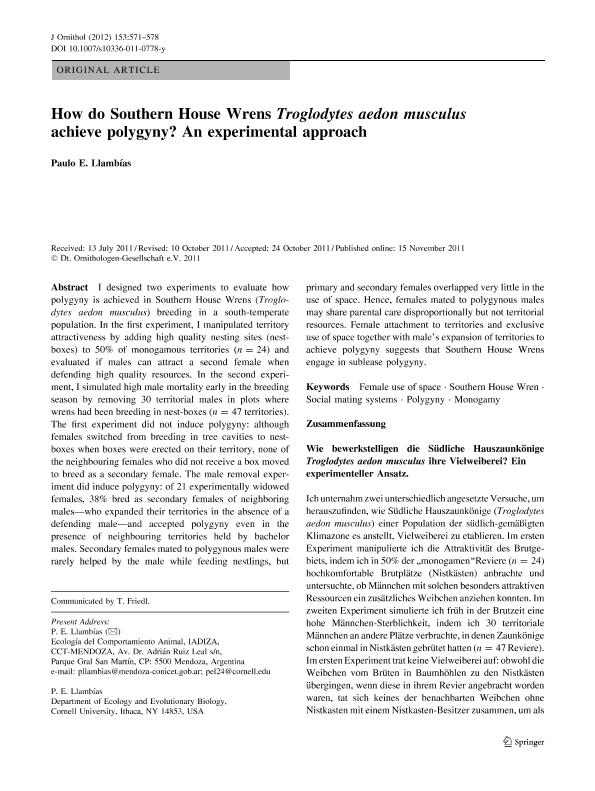Mostrar el registro sencillo del ítem
dc.contributor.author
Llambias, Paulo

dc.date.available
2018-05-11T19:55:30Z
dc.date.issued
2012-08
dc.identifier.citation
Llambias, Paulo; How do Southern House Wrens Troglodytes aedon musculus achieve polygyny? An experimental approach; Springer; Journal of Ornithology; 153; 2; 8-2012; 571-578
dc.identifier.issn
1519-888X
dc.identifier.uri
http://hdl.handle.net/11336/44971
dc.description.abstract
I designed two experiments to evaluate how polygyny is achieved in Southern House Wrens (Troglodytes aedon musculus) breeding in a south-temperate population. In the first experiment, I manipulated territory attractiveness by adding high quality nesting sites (nest-boxes) to 50% of monogamous territories (n = 24) and evaluated if males can attract a second female when defending high quality resources. In the second experiment, I simulated high male mortality early in the breeding season by removing 30 territorial males in plots where wrens had been breeding in nest-boxes (n = 47 territories). The first experiment did not induce polygyny: although females switched from breeding in tree cavities to nest-boxes when boxes were erected on their territory, none of the neighbouring females who did not receive a box moved to breed as a secondary female. The male removal experiment did induce polygyny: of 21 experimentally widowed females, 38% bred as secondary females of neighboring males—who expanded their territories in the absence of a defending male—and accepted polygyny even in the presence of neighbouring territories held by bachelor males. Secondary females mated to polygynous males were rarely helped by the male while feeding nestlings, but primary and secondary females overlapped very little in the use of space. Hence, females mated to polygynous males may share parental care disproportionally but not territorial resources. Female attachment to territories and exclusive use of space together with male’s expansion of territories to achieve polygyny suggests that Southern House Wrens engage in sublease polygyny.
dc.format
application/pdf
dc.language.iso
eng
dc.publisher
Springer

dc.rights
info:eu-repo/semantics/openAccess
dc.rights.uri
https://creativecommons.org/licenses/by-nc-sa/2.5/ar/
dc.subject
Female Use of Space
dc.subject
Southern House Wren
dc.subject
Soicial Mating Systems
dc.subject
Polygyny
dc.subject
Monogamy
dc.subject.classification
Otras Ciencias Biológicas

dc.subject.classification
Ciencias Biológicas

dc.subject.classification
CIENCIAS NATURALES Y EXACTAS

dc.title
How do Southern House Wrens Troglodytes aedon musculus achieve polygyny? An experimental approach
dc.type
info:eu-repo/semantics/article
dc.type
info:ar-repo/semantics/artículo
dc.type
info:eu-repo/semantics/publishedVersion
dc.date.updated
2018-04-24T16:45:30Z
dc.identifier.eissn
2193-7206
dc.journal.volume
153
dc.journal.number
2
dc.journal.pagination
571-578
dc.journal.pais
Alemania

dc.journal.ciudad
Berlín
dc.description.fil
Fil: Llambias, Paulo. Consejo Nacional de Investigaciones Científicas y Técnicas. Centro Científico Tecnológico Conicet - Mendoza. Instituto Argentino de Investigaciones de las Zonas Áridas. Provincia de Mendoza. Instituto Argentino de Investigaciones de las Zonas Áridas. Universidad Nacional de Cuyo. Instituto Argentino de Investigaciones de las Zonas Áridas; Argentina
dc.journal.title
Journal of Ornithology
dc.relation.alternativeid
info:eu-repo/semantics/altIdentifier/doi/http://dx.doi.org/10.1007/s10336-011-0778-y
dc.relation.alternativeid
info:eu-repo/semantics/altIdentifier/url/https://link.springer.com/article/10.1007%2Fs10336-011-0778-y
Archivos asociados
